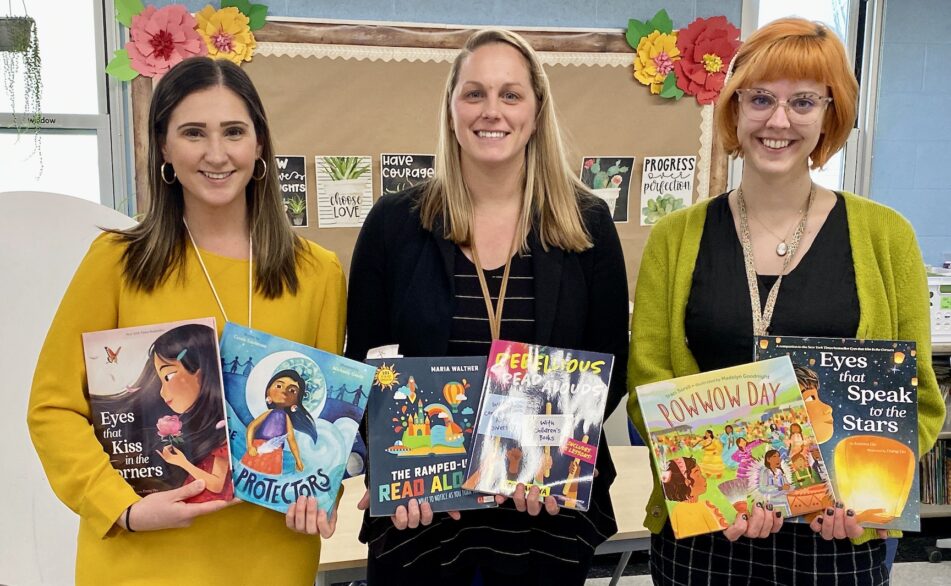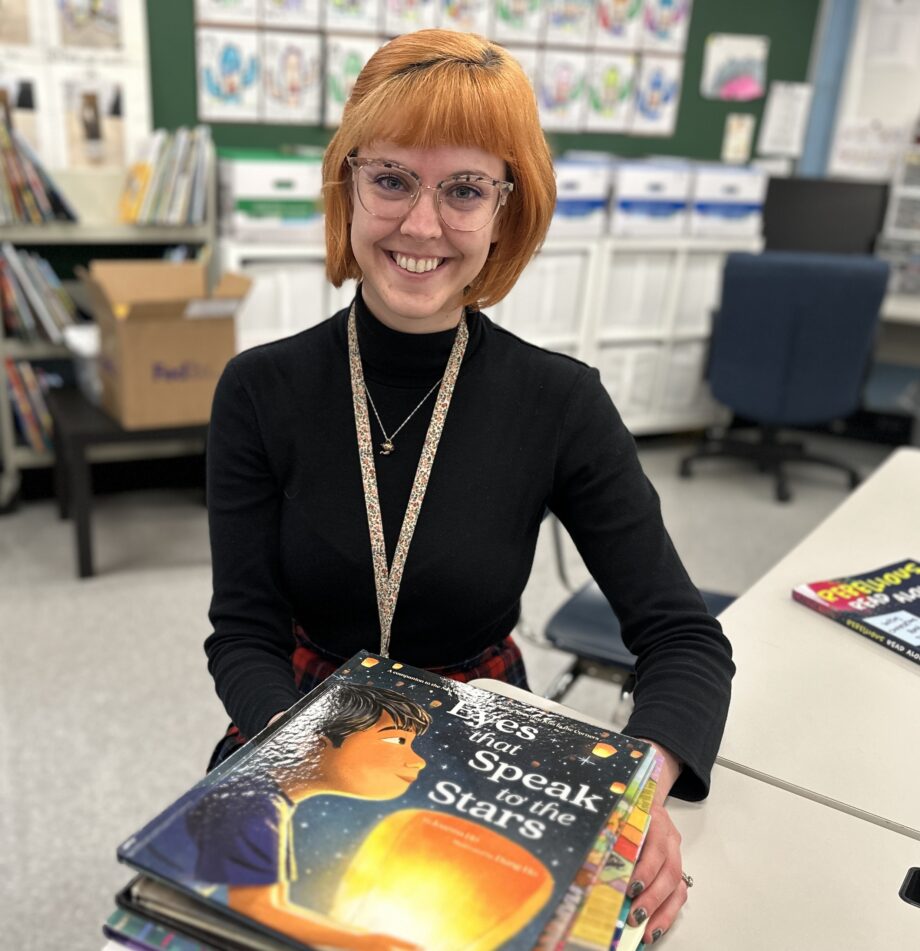By Jo Mathis/AAPS District News Editor
From providing new books celebrating diversity to field trips to a large format printer, the 2022 Ann Arbor Public School Education Fund (AAPSEF) Grants will benefit AAPS students in a variety of exciting and innovative ways.

These grants are managed and administered by the Ann Arbor Area Community Foundation in partnership with AAPS. The fund supports classroom projects that enhance and enrich the learning experience and provide the skills and proficiency required for employment and further education for all students. AAPSEF grants were awarded to eligible schools (those with at least 25% of students qualifying for free/reduced lunch) for programs and projects aligned with AAPS’s priority areas.
As always, each of the requests was for programs that have the success of the students at the forefront, said Maryellen Ferro, the Foundation’s Community Investment Officer.
“It is easy to tell from the applications how passionate each of the applicants is about the work they do in the schools,” Ferro said. “It is very clear that the teachers, administrators, counselors, etcetera are huge advocates for the students that they work with.
“Each of the projects impressed me and the committee for different reasons. Whether it was to bring more diverse, inclusive books to the school or to equip middle school girls with social and emotional skills, they were all focused on impacting the students’ experiences at school. “
I am continually impressed and thankful that students in AAPS schools have so many people working to help them thrive.
Maryellen Ferro, Community Investment Officer, AAACF
The grants from the AAPS Education Fund allow our schools to find innovative ways to support our students, said Nancy Shore, Director, Strategic Partnerships and Community Engagement.
“The grant’s focus on Diversity, Equity, and Inclusion is directly in line with the strategic focus of our district,” she said. “We are grateful to have such a strong partnership with the Ann Arbor Area Community Foundation.”

This year projects had to address (1) literacy (2) science & tech (3) the arts (4) mental health (5) COVID or (6) DEI and only schools that have Title 1 status or at least 25% of the student body received free/reduced lunch were eligible to apply.
Application requests this year (and in years past) could not exceed $2,000. There were projects that needed as little as $145 and those which requested the full $2,000. We received 36 applications – many of which supported the advancement of reading and writing skills.
More high-quality STEM toolkits and books at Abbot and Angell
Dana Friedman, the librarian at Abbot and Angell elementary schools, applied for the grant because she wanted to make sure that her students had access to equitable, high-quality STEM education.
“And one way to do that was to get resources in the library for ALL students Y5-5 grade to support their skills in STEM,” she says. “I plan to purchase high-quality STEM toolkits and books to foster learning opportunities in STEM with funding from the grant.”
She said every student belongs in STEM and they deserve to have educational experiences that empower their full potential as contributing members of the workforce in the future.
“It felt natural to do this in the library, as this is really where research, information acquisition, and life-long learning happens,” she says. “The hands-on activities we will do in the library with the STEM resources purchased with funds from the grant teach children more than science, technology, math, and engineering, but also help develop their creativity and problem-solving skills. The library is a place where deep learning happens that connects many subjects; this will ultimately help students learn more, as well as succeed in school and beyond.”
Building a Diverse, Inclusive, Exciting 2nd Grade Library at Pittsfield
Pittsfield second grade teacher Chelsea Froning said she was inspired to apply for this grant while reflecting on the library her mentor teacher had built out for her fourth graders.
“This library was full of amazing books that would meet all her students’ needs and interests, and she frequently added new titles to keep kiddos invested,” says Froning. “I was lucky enough to inherit this library as I transitioned into teaching 4th grade, but had to leave the majority of the books we had collected together behind as I made the transition to teaching 2nd grade this year. I was so excited to see this opportunity pop up to get the funding I needed to make this happen for my second graders!”
She said her students will benefit from the project by having a wider variety of diverse, inclusive, engaging text at their fingertips, providing them with the opportunity to become better-educated, more compassionate citizens of the world.
“Students in second grade moving forward will have a wider variety of texts available to them, so that they have a broader experience of humanity available via their Reading Workshop,” she said. “We would love to share our library more broadly across the school as well.”
More supplies for Spanish education at Carpenter
Carpenter teacher Rosana Lubara-Steuer says her family budget is what inspired her to apply for the grant which will pay for the subscription renewals and so much more for her students—things til now she’s paid out of her own pocket.
“My dear husband always complains about all the money I spend on subscriptions such as teachersdiscovery.com, teacherspayteachers.com, Blooket.com, Rockalingua.com, and Quizlet.com., etcetera,” she says. “I buy my supplies because there are no budgets for the Spanish teacher in any of the four schools I teach. If I need mini whiteboards, dry-erase markers, classroom decorations, etc., that always comes from my pocket.”
She says that as a traveling Special area teacher, she isn’t included in the supply order as Music, Gym, Art, or PLTW teachers are.
“I teach not only the language but also the culture,” she says. “Therefore, I invest my own many buying materials for cultural arts and crafts.”
More books to Read Aloud coming to Lakewood
Three Lakewood teachers who compost the Building Support team—English Learner Teacher Eleni Kastanis, Fjollza Asani, and Melissa Schmidt —applied for the grant as a tangible way to support the district’s affirmation of dignity.

“We were inspired to disrupt implicit bias and enhance the practice of Read Aloud in service of our Lakewood students,” said Kastanis. “Read-alouds can create equity, in that every student has access to a grade level appropriate text through listening to their teacher read fluently. Read Alouds help students learn content and the reading process by providing structured access to print concepts, text features, vocabulary, and comprehension.
The teachers looked at research-informed practices from the Michigan Literacy Essentials. Michigan Literacy Essential 2 states that interactive read-alouds are crucial to develop strong readers. Their project will provide teachers and students access to high-quality fiction and nonfiction texts on a variety of topics. Engaging titles on this list include diverse characters and figures, social-emotional learning, playing with language, and building classroom community.
Kastanis said the goal is to get students thinking and talking about information they learn in books and to continue discussing topics long after a book is finished.
“By informing our instruction through a lens of equity for all students, this program would enable access to rich text,” she said. “Students of all backgrounds will have opportunities to be seen and successfully engage with their peers, and have practice with academic concepts and language.
We as educators have to lift the message—not rely on the book to do the lifting.”

Large format printer for design students at Huron High
Huron High School art teacher Soyeon Kim is excited about being awarded a grant she’ll use to purchase a large format printer for my graphic design students.
“The size of an artwork matters and I have always wanted to print the design projects larger but didn’t have a proper printer to do so,” she says. “I previously printed pieces of a project and glued them together or went to Office Depot for a few larger prints. Now, with the large format printer, I can print up to 24-inch wide posters. I am counting on it for the upcoming Huron Art Night on January 11th, of course, if the printer arrives on time.”

Be the first to comment